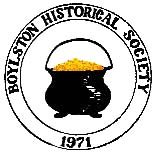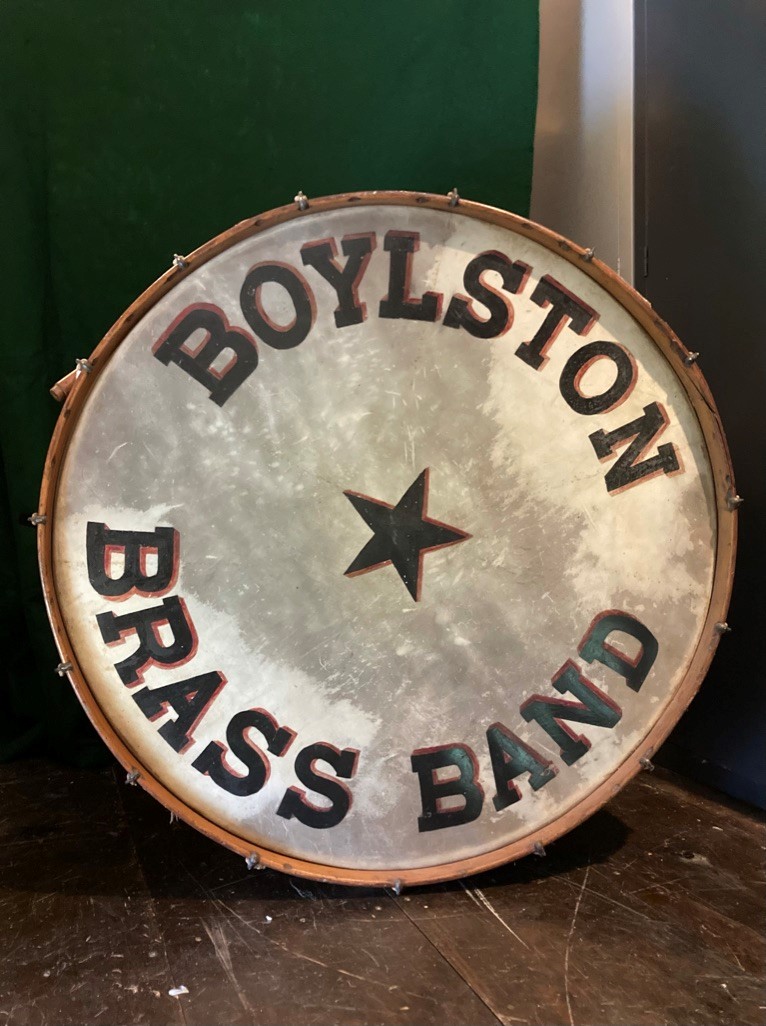Boylston Bass Drum
The Bass Drum
of the Boylston Brass Band
By Carrie Crane
It was in Victorian England, as industrialization was bringing workers to the cities, that community brass bands began to spring up across the country as a constructive way to use free time after work. This trend spread to the United States by the middle of the 19th century and in 1875 a group of Boylston men, jumping on the bandwagon (forgive me), came together to start their own town brass band.
Over the 5 years of its existence, the Boylston Brass Band played for weddings, anniversaries, town events, ice cream socials, and church suppers. Most of the players secured their own instruments, but the band took responsibility for the percussion side of things. In the early days, when funds were lean, the band rented a bass drum. That changed when on March 16th, 1876, after being together for only several months, the band held a fair at the Boylston Town Hall (current home of the Boylston Historical Society & Museum). Although it was reported to be a stormy night the event was a success with sales of $140, leaving the band $95 in profits after their expenses were paid. This was enough for the band to not only buy a bass drum and set of cymbals, but left remaining funds to put toward their general expenses.
Archeological evidence places the earliest percussive instruments to 30,000 years ago. These were simple instruments, rocks, sticks, stamping feet. It is thought that they might be the same instruments primitive humans used as weapons. Over time, materials were selected or altered to create more intentional vibrations through shaking, as with a gourd strung with shells, or rubbing together as with notched sticks. There is evidence that shallow pits were dug in the dirt and a rigid material placed across them to amplify the stamping of feet. This was perhaps the first form of the drum. The purpose of these instruments was to direct dancers in their ritual movements and thus they carried with them a certain mystical power.

Battesimo dei seleniti (Baptism of the Selenites) by Vittore Carpaccio,1502,
Over centuries, percussion instruments were developing simultaneously in China, Mesopotamia, North and South America, and across the African continent. The bass drum as we know it now can be traced back to Turkey and its 16th century Janissary Military music. The drum of this era was large in circumference but not wide. Played vertically, the drum was either supported by a stand or hung from the shoulders resting against the chest of the player. Wearing it this way allowed the musician to march along with the other band members. It was played on both sides with the drummer holding mallets in both the right and left hands. Turkish troops brought this military music to Europe in the 18th century where the style and instrumentation was quickly adopted.
By the time the expansion of the brass band movement spread from Britain to the US in the mid-19th century, this style of bass drum had become an essential part of the band. From before Janissary music, all the way to modern times, the bass drum has held the critical role of emphasizing the rhythm of the music, controlling the speed, and providing a grounding tempo for all the other band musicians. The mystical aspect of the drumbeat has diminished.
The Boylston Brass Band bass drum. 1875. Sold by S. R. Leland and Co., Worcester, MA. The drum is 36” in diameter and 15” wide. It was tuned by tightening the ropes that secure the ring holding the head in place. The original ropes (like made of hemp) have been replaced and the tuning hardware lost. But the beautifully painted head remains as striking as ever.
The Boylston Brass Band bass drum, strikingly painted with the name of the Band on one head, is now in the collection of the Boylston Historical Society and Museum. It was donated in 1975 by Arthur Flagg (Boylston, 1 907-1997) the son of George A Flagg (Boylston,1885-1928) who along with two other distant Flagg cousins, Montraville Flagg, Jr. (Boylston, 1849-1910) and John T Flagg (Boylston, 1859-1878) were members of the Boylston Brass Band. The drum was said to have been played by Jack Wood (Boylston 1868-1940), the son of John Avery Wood Jr and Rebecca Hastings.
When this drum was purchased in 1876, it likely cost no more than $30. The label on the interior of the drum indicates it was purchased from the S. R. Leland and Co., Worcester Ma. Samuel Reeved Leland started his music and umbrella store in 1839 in Worcester. At the time the drum was purchased, the store was located at 343 Main Street (the address seen on the label) but was soon to move to a new location at 446 Main Street across from the City Hall. The new building was four stories tall and had one floor dedicated to band instruments. Samuel passed the company onto his son Frank Leland in 1908 who continued operating it until his death in 1915.
The Boylston Brass Band played together until the end of 1880 when their band leader, Walter Hastings moved to the southwest for health reasons. Only a little more than a year before this their previous Band leader, John T. Flagg died at the age of 19. These two events seemed to take the wind out of their sails, or rather the rhythm out of their drum, and they disbanded. Thankfully the bass drum was very well cared for since that time and is now on display at the Boylston Historical Museum.
To read more about the Boylston Brass Band and its members, see previous article
________________
Acknowledgements:
A Record of the Boylston Brass Band Organized Nov. 15th 1875, Boylston Historical Society Museum.
Blades, James. Percussion Instruments and Their History. United Kingdom, Bold Strummer, 1992.
Editor, Nancy A. Filgate. Boylston Historical Society, Director, Boylston, Massachusetts
https://www.findagrave.com/
https://www.vsl.co.at/en/Bass_drum/History/
https://www.brasshistory.net/Leland%20History%202.pdf
https://www.google.com/books/edition/Percussion_Instruments_and_Their_History/a8V3Z6j2ExEC?hl=en&gbpv=1&bsq=bass%20drum
https://www.asbadrums.com/gb/content/101-history-of-the-bass-drum
https://en.wikipedia.org/wiki/Bass_drum
https://www.historicbrass.org/edocman/hbj-1992/HBSJ_1992_JL01_001_Herbert.pdf
https://nabba.org/what-is-a-brass-band/
Image: https://commons.wikimedia.org/w/index.php?curid=9770928
Photography of drum, Carrie Crane


